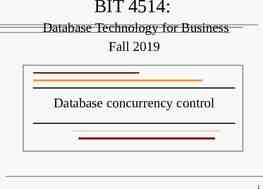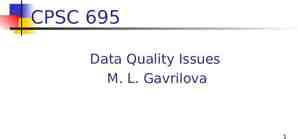Transit Signal Prioritization (TSP) Considerations within RTS
25 Slides4.28 MB

Transit Signal Prioritization (TSP) Considerations within RTS Corridors Rapid Transit System Steering Committee Technical Memorandum 2 Existing Conditions Signal Systems & Corridor Operations December 17th, 2013 1

Key Findings 10 Route RTS network has 116 stations overlaying 284 existing traffic signals and 820 existing bus stops Implementing advanced TSP within RTS requires close coordination of existing agencies and systems. Cannot be done in isolation. Existing signal controllers/ central software currently does not support all advanced TSP functions Would require time and cost to upgrade, cost TBD Primary traffic control system function is to monitor signal performance for roadway safety and mobility TSP is a secondary function within overall operations Incorporating WMATA buses into RTS would require additional hardware and software, cost TBD Council resolution shifts TSP decisions based on ROW treatment to Facility Planning stage 2

Priority Transit Corridors and Montgomery County Signals Countywide Transit Corridors Functional Master Plan Planning Board Draft (MNCPPC, July 2013)

Summary Table 1.0 8 24 3 48 3.9 2.2 20 37 23 120 14.1 3.5 14 47 22 106 9.3 0.0 12 34 4 89 8.5 2.8 3.8 7 14 1 23 2.7 0.3 1.5 11 30 7 105 10.1 10.1 9 21 5 76 5.5 2.7 11 22 7 70 11.0 3.4 11 18 5 69 6.2 116 277 82 820 81.0 2 Lane New ROW Busway (2 way) 9.6 2 Lane Median Busway (2 way) 114 2 Lane Side Busway (2 way) 5 1 Lane Median Busway (1 way) Mixed Flow 30 1 Lane Medan Busway (bi-dir) Length (Miles) Managed Lane (dedicated 1 way Pk) Bus Stops 13 Mixed Flow w Queue Jump Signals with V/C 0.95 To Signals From Stations (RTS & Metro) Corridor Dedicated Curb Lanes Miles MNCPPC Funtional Master Plan Planning Board Draft Georgia Avenue 6 Transitway Montgomery General Hospital Wheaton Metrorail Station Corridor Cities Transitway Rockville Metrorail Station Colesville Park & Ride White Flint Metrorail Station 7 Randolph Road US 29 1 North Georgia Avenue 2 South 3 MD 355 North 4 MD 355 South New Hampshire 5 Avenue North Bethesda University 8 Boulevard 9 US 29 10 Veirs Mill Road Wheaton Metrorail Station Burtonsville Park & Ride Rockville Metrorail Station Wheaton Metrorail station District of Columbia line Rockville Metrorail station District of Columbia line District of Columbia line Montgomery Mall Transit Center White Flint Metrorail Station Takoma/Langley Transit Center District of Columbia line Wheaton Metrorail Station Totals 8.6 1.7 10.6 1.2 8.2 1.8 0.9 2.8 1.1 0.9 5.6 6.2 25.9 0.0 4.0 0.9 6.2 16.8 0.9 26.2 0.0

Traffic Signals in Montgomery County by Ownership/Operation & Potential TSP Corridors

Owns Traffic Signals in Montgomery County by Ownership & Operation County MDSHA Rockville Total County 274 522 6 802 91% Operates MDSHA Rockville 0 0 29 6 0 42 29 48 3% 5% Total 274 557 48 879 100% 31% 63% 5% 100% 63% Owned by the State of Maryland 31% Owned by Montgomery County 5% Owned by the City of Rockville 91% Operated by Montgomery County Approximately 30 of the MDSHA signals in and around Takoma Park & New Hampshire are not operated by the County – 10 will migrate to County operations in the near future – 15 are along New Hampshire Avenue (4 outside the County) Majority of the Signals along the RTS routes are owned by MDSHA

Montgomery County Advanced Transportation Management System (ATMS) Traffic signal operations key component of ATMS Traffic Signal System Modernization Completed in 2012 – New computer and servers – Custom traffic operations and ATMS Software – Upgrade of all MDSHA and County traffic signal controllers to modern Econolite ASC/3 controllers – High speed communications network for real time operations – Distributed signal control system (using the ASC/3 controllers) Each ASC/3 controller is TSP ready (with 400 TSP data key) Developed/tested recommended TSP Architecture: – Econolite ASC/3 controllers – GTT Opticom GPS Spread Spectrum TSP system – ORBCAD Transit Automated Vehicle Location/Computer Aided Dispatch

Montgomery County Recommended TSP Architecture ATMS Operations Center Transit Management ORBCAD Central Software Traffic SIGNAL GPS 1 Vehicle Tracking & Detection Monitoring and logging data AVL & Computer Aided Dispatch ATMS Central Operations Software Traffic Management I Am HERE Vehicle is in range Who gets Priority Signal Strategy to use 3 Priority Request Server 2 Priority ORBCAD Veh. Components: I am Late Request Generator I Want Priority GTT Opticom GPS TSP System 4 ASC/3 Signal Controller Adjusted phases 8 In cycle

Recommended Countywide TSP Concept of Operations Assumes Current Service – Transit vehicles in mixed flow without other priority measures – No differentiation between types of transit service TSP Request when bus is more than 5 minutes late TSP Granted on first come first served basis TSP Signal Strategies – Green Extension – Early Green Signal coordination allowed to “recover” between instances of signal priority – 3 cycles between granting requests)

Issues of Concern to RTS from Current Systems Review (1) Current Montgomery County System can implement: – Early green, – Extended green – Leading green for queue jumps Other TSP Signal Strategies will be costly and require changes to the overall system (beyond firmware v 2.50) GTT Opticom GPS TSP System – Recommended for Montgomery County and WMATA – WMATA's recommended system uses different communications. – WMATA System in Montgomery County Need cellular modems at the roadside (cabinet) for each signal location Tests to make sure inputs from Ride On and WMATA can work together

Issues of Concern to RTS from Current Systems Review (2) Automatic Vehicle Location/Computer Aided Dispatch – Ride On ORBCAD AVL/CAD system tested for TSP in Montgomery County – Not Used by WMATA (Clever Devices) – AVL/CAD for RTS needs to be determined. City of Rockville – No signals operated by Rockville directly on the RTS corridors – Two signals on CCT right of way – Potential for TSP at Rockville signals with diversions to reach special destinations (e.g. Community College) – Any integration with the Rockville system will require upgrades to its controllers and/or central software. Integrating Current MTA Commuter Service (provided by contractors with no AVL/CAD) requires added technology RTS will need to integrate/coordinate with CCT and Purple line.

RTS ROW Priority Treatments versus TSP Signal Operations Potential Signal Treatments* ROW Treatments Non-RTS Corridor Current Signals Passive 595 Mixed Flow 84 Mixed Flow w Queue Jump 0 Dedicated Curb Lanes 19 Managed Lane (dedicated 1 way Pk) 4 1 Lane Medan Busway (bi-dir) 18 1 Lane Median Busway (1 way) 57 2 Lane Side Busway (2 way) 4 2 Lane Median Busway (2 way) 98 LRT ROW (Purple Line) 14 Extend Green Red Truncate Insert Transit Phase Rotation Phase Phase /Swap Suppression Transit only Early Green * Insert Transit Phase, Phase Rotation, & Phase Suppression would require upgrade of Signal System Software

Other Characteristics impacting TSP (Turns, Other Service) ROW Treatments Non-RTS Corridor Mixed Flow Mixed Flow w Queue Jump Dedicated Curb Lanes Managed Lane (dedicated 1 way Pk) 1 Lane Medan Busway (bi-dir) 1 Lane Median Busway (1 way) 2 Lane Side Busway (2 way) 2 Lane Median Busway (2 way) LRT ROW (Purple Line) Turns Permitted Right Left Y Y Y Y Y Y Fac Plng Y Fac Plng Y Fac Plng Fac Plng Y Fac Plng Y Y Y N Fac Plng Fac Plng Transit Service in Priority ROW Traffic Lane Use LRT RTS Express Local Y N Y Y Y Y Y Y Right Trn Y Y Y Right Trn* Y Y Y Right Trn* Y Y Y N Y Fac Plng N N Y Fac Plng N N Y Fac Plng N N Y Fac Plng N N Y Fac Plng N N * If permitted

Factors influencing TSP Strategies at Specific Intersections Roadway: – Intersection Level of Service – Available green time (slack) – Cross street facility type – Bicycle & Pedestrian treatments and priority areas, Transit: – Other Transit Service in the Corridor – Cross street transit service – Bus stop/station locations – Service frequency – Time between priority requests – Ridership

Overall System and Policy Decisions Needed Can’t determine TSP at specific intersections until facility planning for each corridor Can/Should decide: – Integrated or separate Operations centers Communications TSP systems and equipment – TSP Architecture (centralized, distributed, communications, etc.) – Recommended TSP by ROW Priority Treatment Types of transit service receiving TSP in corridor Decision strategy for enabling TSP and each intersection Conditional parameters (direction, time of day, schedule, passengers, frequency of granting requests) Types of TSP signal strategies to provide for – RTS and Purple Line integration

Technical Memorandum 3, RTS & TSP Findings & Recommendations: What do we have today, what do we want to have in the future? Cost to deploy all add-on TSP configurations within the current signal system Concept of operations – defined scenarios with – RTS vehicles only – RTS and other transit providers in RTS ROW – RTS and conflicting local transit outside RTS ROW – RTS and conflicting LRV outside RTS ROW What needs to happen for each type of strategy/ ROW – Technology, agency agreements, etc.

Back up Slides

Econolite ASC/3 Controller Controls signal phasing, TSP strategy length of priority, lock out periods (16 phases max) Current advanced controller offered by Econonlite Compatible with Standards (NEMA TS2, NTCIP 2011) 1 TSP request addressed per cycle (check in/out or continuous monitoring) TSP ready (with 400 TSP data key) TSP Strategies with current firmware (v 2.45, planned 2.49) – Extended green – Early green – Leading green for queue jump Additional features/strategies dependent on firmware v 2.50 and above Firmware v 2.50 and above incompatible with ATMS Central Operations Software. Very costly to upgrade

GTT Opticom GPS TSP System Recommended for Montgomery County existing system Also selected by WMATA (with differences) and MDSHA in other areas (for preemption). On MDSHA procurement schedule. Components/functions – On-vehicle (PRG: sends request when criteria are met) – Wayside antennae (spread spectrum) to receive vehicle location – Phase selector (PRS: validate position, in range ?, prioritize/resolve conflicts, send request to controller) Additional central software to provide monitoring and logging data also recommended Proved technically feasible in Route 55 MD 355 TSP test How to integrate across operating agencies / services remains to be seen

ORBCAD AVL/CAD System Automatic Vehicle Location and Computer Aided Dispatch system implemented by Ride On Currently provided by ACS Systems/Xerox (has gone through several transitions) Functions – – – – – – – Real time vehicle location and monitoring Schedule and route adherence Data and voice communications (mobile data terminal) Voice annunciation for stops along routes Silent alarm Automatic Passenger Counts TSP integration to identify late vehicles, passengers, etc. Integration with TSP proven technically feasible in Route 55/MD 355 TSP test.

City of Rockville Signal System 143 signals within or near Rockville Boarders City owns 48 signals City operates: – 42 of its own signals – 6 of the MDSHA signals Econolite ASC/2 Controllers with limited TSP capability Aires Closed Loop traffic system with dial up connection (not real time) No City Signals directly on RTS Routes 2 City Signals on the CCT corridor

Ride On Montgomery County Transit (Ride On) Weekday service: – 78 routes – 289 peak vehicles Provides service in every proposed RTS corridor Operations colocated with traffic but not integrated Trapeze bus scheduling and run-cutting software Smart Traveler Customer Information Regional Smart Card Fare Payment Implementing Automatic Passenger Counters ( 55%) ORBCAD Avl/Cad system – Will allow Conditional TSP on Schedule Adherence and Passenger Loads Only Route 55 TSP vehicles for TSP Test equipped with GTT Opticom GPS TSP systems

Washington Metropolitan Area Transportation Authority (WMATA) Consolidated onboard & fixed end equipment in 2012/2013 Clever Devices AVL/CAD GTT Opticom TSP software/ hardware From: A. Young Leveraging the WMATA CoABE Project Technology for TSP Implementation (ITS Maryland, October 2013) Cellular communications with the Intelligent Vehicle Network (IVN) Unit Roadside (cabinet) cellular modem with GPS Econolite ASC3 controller through GTT Phase Selector

Washington Metropolitan Area Transportation Authority (WMATA) Service – 140 Metrobuses in peak periods within Montgomery County – Primarily regional service along major corridors – WMATA service in every proposed RTS corridor Issues – Installation, recurring costs, maintenance of cellular modems within Montgomery County signal cabinets – Reconciliation/integration between WMATA Cellular and Montgomery County Spread Spectrum vehicle to roadside communication (can inputs be received and integrate from both) – Resolving competing priority requests between Montgomery County and WMATA vehicles – Communication/coordination between operation centers

Maryland Transit Administration (MTA) Current Service – – – – – – – Route 201 Route 202 Route 203 Route 204 Route 915 Route 929 Route 991 – Route 995 Gaithersburg to BWI Marshall Airport Metropolitan Grove to DOD/Ft. Meade Columbia to Bethesda Frederick to College Park Columbia/Silver Spring to Washington, DC Columbia/Silver Spring to Washington, DC Hagerstown/Frederick to Shady Grove/Rock Spring Business Park Clarksville/Ellicott City/Columbia to Washington, DC Contract Service with no AVL/CAD or other technology requirements Future Systems (will need to coordinate) – Purple Line – Corridor Cities Transitway (CCT)






